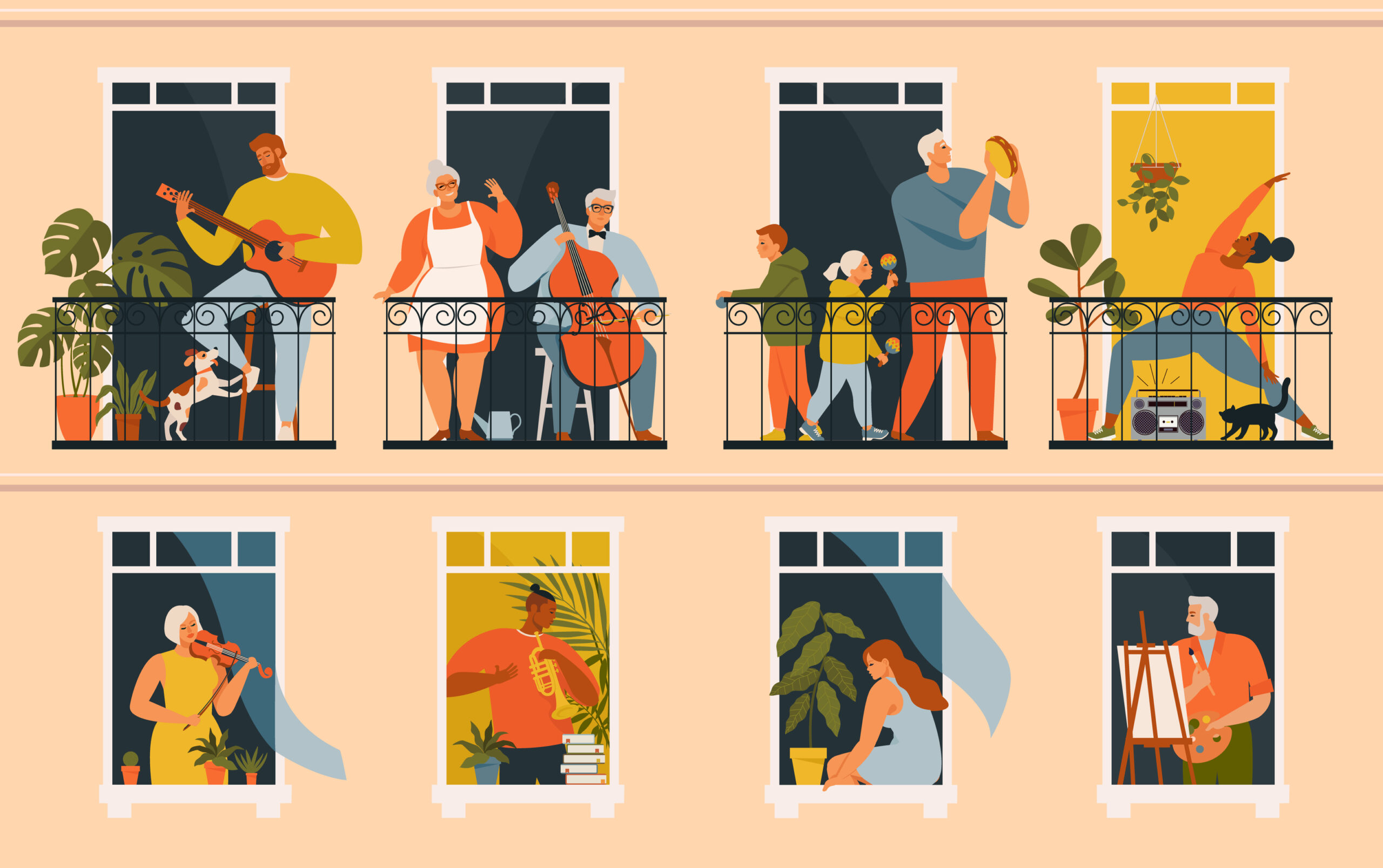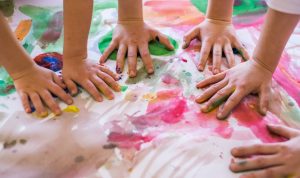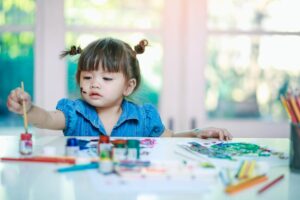Effects of Arts and Crafts in Public Mental Health Education with their very different styles due to many factors such as times, regions, technologies, and cultures and nationalities, have undergone an extremely long process, and it is only through continuous superimposition, development, and innovation that they have gradually formed the posture of today’s arts and crafts. Public mental health education is the main way to promote the psychological health development of the public in colleges and universities at present. And among them, sound personality and good self-awareness is one of the important standards of psychological health of the large public and one of the important tasks of mental health education. As an effective psychological test and treatment method, arts and crafts analysis are an important part of mental health education. It has a certain role in improving the level of self-awareness and promoting the integration of personality. Art and craft analysis has advantages in mental health and educational group counseling that cannot be replaced by other words and activities, so it can be used in mental health education courses. It can be used in teaching self-awareness. In order to combine the development of arts and crafts with the development concept and promotion ideas of public mental health education, this article proposes an analysis of the role of arts and crafts in public mental health education based on artificial intelligence computing to enhance the development of arts and crafts from a new perspective and seek the inheritance and innovation of arts and crafts and public mental health education in the new historical period, and proves the proposed method in the relevant dataset. The validity of the proposed method is demonstrated in the relevant dataset.
Introduction
Arts and crafts are a unique art discipline that has a long history in China and has been explored and developed over a long period of time to become a relatively mature and complete discipline in the art field. Art and innovation have always been complementary to each other, and it is the continuous innovation and optimization from simple to complex and from rough to fine that has led to the development of arts and crafts design, which has evolved into an important factor affecting the daily production and life of human beings. In the case of arts and crafts design, its development process is the process of innovation. Only by keeping pace with the times and synchronizing human aesthetic concepts can arts and crafts design achieve sustainable development.
First, innovation in arts and crafts design is conducive to strengthening the infectious power of artworks. In the design of art and craft works, designers should not stick to the rules and design according to the corresponding templates. Innovative arts and crafts design should be made to strengthen the artistic charm and infectious power of arts and crafts works, to obtain the favor of most audience groups. Secondly, the innovation of arts and crafts design is conducive to meeting people’s spiritual needs. At present, arts and crafts works are popular among people, which makes designers deeply feel and realize the huge potential of arts and crafts design work, prompting them to complete the design work independently and actively. However, this change in thinking has also directly increased the pressure of designers’ work, and people’s requirements for arts and crafts design have gradually begun to change towards deep spiritual needs. In this regard, designers must target innovation and improvement, to meet people’s spiritual needs to the greatest extent. Again, the innovation of arts and crafts design is conducive to optimizing the characteristics of artworks. In the process of arts and crafts design, the introduction of innovative thinking can promote designers to analyze the value of arts and crafts works based on different perspectives and levels of deep consideration, to ensure that arts and crafts works can have both aesthetic and functional characteristics.
Sponsered1
Art education can cultivate people with a sense of beauty, allowing them to see beauty in the most ordinary things; it also enables them to know how to use ordinary things around them to create beauty, giving them a positive and happy attitude towards life, and it enables them to face the hardships of life with a sense of beauty. As an important component of art education, arts and crafts is precisely the purpose of self-healing and nurturing the healthy growth of the mind through the transfer and transformation of creativity and aesthetic experience by using the perception of beauty in its unique nonverbal expression. Therefore, we should actively explore the psychological healing function of arts and crafts, that is, the healthcare of arts and crafts for the healthy psychology of the subject. The origin of art therapy can be traced back to prehistoric times, when humans felt fear and panic about many unknown phenomena such as nature and man himself, so they left many murals in caves to express their awe to relieve their inner pressure.
Today, modern medical psychologists have shown through their research that art has a significant therapeutic and healthcare effect in regulating psychological anxiety and emotional disorders in modern people. They believe that art and its educational activities are a kind of panacea for maintaining and improving physical and mental health, and a kind of nonverbal psychotherapy that is quite effective. Through arts and crafts, calligraphy, seal engraving, sculpture, architecture, etc., art and its educational activities explore, express, and create beauty, so that the subject can feel beauty, appreciate beauty and love beauty in the process of education, cultivate beautiful ideas, and use the psychological suggestion of beautiful ideas to create a lively and pleasant spiritual realm, so that life is full of health and vitality, and the mind is calm and peaceful. The suggestiveness and creativity of this good intention can fully mobilize the psychological potential of individuals, so that their physiological functions show a good emotional reflection, the cerebral cortex, and the central nervous system to produce a positive stimulation and promote a more pleasant and strong body and mind.
As a special group of young people loaded with high expectations from family and society, the contemporary public is facing more opportunities and at the same time is under greater psychological pressure and challenges. In this sense, the public is a high-risk group for mental health problems. According to a national sample survey, 23% of the public has different degrees of mental health disorders or psychological abnormalities. Growing adults are more likely to experience more anxiety and frustration due to their unstable state of mental activity, incomplete cognitive structure, lack of synchronization between physiological and psychological maturity, and lack of identification with society and family, and are therefore more likely to have psychological problems. If temporary psychological barriers are not eliminated in time, they will produce adverse reactions and affect the healthy development of the psyche in the future and may even lead to psychological disorders that are difficult to save in the future.
Sponsered1
From the development of arts and crafts in recent years, the use of artificial intelligence in the field of arts and crafts has gradually become widespread. Especially in the process of arts and crafts design education and teaching, the use of artificial intelligence helps to improve the aesthetic level and improve the quality of teaching. Arts and crafts built on artificial intelligence can show static knowledge in a dynamic mode, helping the public to understand art- and design-related knowledge more intuitively. In addition, arts and crafts design has humanistic and artistic characteristics, and the effective combination of big data, AI technology, and VR technology in the age of artificial intelligence can promote the cultivation of public aesthetic consciousness, spread public thinking, and guide them to establish correct mental health concepts. Therefore, under the era of artificial intelligence, arts and crafts design should change its own concept, integrate various technologies and advantages involved in artificial intelligence into the process of arts and crafts design, optimize teaching resources, innovate teaching mode, create a good artistic atmosphere for arts and crafts, guide the public to feel and experience the beauty of art and design, and realize the innovation and reform of art and design teaching in colleges and universities.
The main contributions of this article are as follows. Firstly, it analyzes that in arts and crafts design, the role of arts and crafts in healthcare for public mental health should be actively explored, and through effective aesthetic penetration and aesthetic deepening, education, and self-education that integrates knowledge, emotion, intention, and action should be implemented, and rich arts and crafts activities should be carried out to cultivate healthy aesthetic consciousness, aesthetic emotion, and aesthetic behavior of the subject to sound psychology and develop personality. This article proposes a model for analyzing the role of arts and crafts in public mental health education by artificial intelligence technology. The neural network model with deep learning can analyze arts and crafts for public mental health education quickly and accurately. The experiments demonstrate the effectiveness of the proposed method and provide a feasible solution for the analysis of the role of arts and crafts in public mental health education in batch and fast.
Related Work
Arts and Crafts Design
The arts and crafts industry, with its profound cultural heritage and exquisite craftsmanship, has opened a new research direction and creative field for the current cultural and creative industries. With a far-sighted view on the inheritance and innovation of traditional arts and crafts, we bring life and vitality to the development of arts and crafts by using classics as inheritance and innovation. How to make traditional arts and crafts rejuvenate is a topic that has been explored in the past few years. Designing arts and crafts that meet the needs of contemporary people, meet the aesthetic value of the public, and have practical functions has become a necessary condition for the transformation and upgrading of arts and crafts. The innovation of arts and crafts needs several aspects to complement each other, such as the improvement of the environment for the development of arts and crafts, the change of design concept, the cultivation of the innovative spirit of arts and crafts inheritors, the integration of arts and crafts with science and technology, and the cross-border cooperation of arts and crafts. These changes are urgent, and only the collision of innovative thinking can give a new vitality, so that our life can be splendid because of innovation, and arts and crafts can be inherited because of innovation.
Sponsered1
The improvement of the environment for the development of arts and crafts is the external condition for the survival of arts and crafts, as the social environment and economic environment interpenetrate each other. If we can change our perspective and our existing habitual way of thinking, we may be able to open new horizons. Unlike pure art, which is confined to the upper class and the literati, arts and crafts are directly related to the society and the people and are closely related to the social environment. A prosperous socioeconomic environment is naturally conducive to the development of arts and crafts and provides a material basis for their development. Only arts and crafts that penetrate deeply into people’s lives can develop harmoniously in the social environment, so that their artistic personality can gain vitality and win people’s consensus.
Nowadays, Chinese elements have become a hot spot of attention on the world stage, and Chinese arts and crafts, with their profound cultural heritage, rich historical connotation, and regional characteristics, are favored by people from all over the world, and arts and crafts as one of the elements play their due function of cultural dissemination. The last decade has been a golden decade for the development of the arts and crafts industry. Consumers’ demand for arts and crafts products has been diversified and multileveled, thus driving the rapid development of the industry and providing a wide space for China’s arts and crafts industry to achieve higher economic and cultural values. No matter what industry the designer belongs to, deep cultural cultivation is necessary, and the designer’s taste directly affects his works. It is important for designers to open their eyes, such as traveling abroad, attending industry exhibitions, and using the Internet are useful ways. An excellent designer should learn a wide range of knowledge, consciously accumulate knowledge, and develop their own ability to feel the beauty, so that they can be in touch with it when designing.
A designer is different from a craftsman or an artist. The creation of an artist is to a large extent a personal act, and he can create works expressing his own ideas at will. The designer’s creation is a social act, holding the concept of human-oriented design and putting the needs of consumers in the first place, and his works are accepted by the public in daily life after forming products. In addition, the designer should also have sufficient understanding of the whole process of the product from design and manufacturing to the market. At present, corporate designers are subject to greater constraints because companies pursue economic benefits first and personalization later.
Sponsered1
Public Mental Health Education
Clinical psychology research shows that emotions dominate health. Maintaining good moods and stable emotions is one of the most helpful forces for physical and mental health in the human body. As an important part of arts and crafts education, the emotional factor is always present throughout the aesthetic and creative activities, and it can be said that it is difficult to produce true beauty without emotion. Healthy and noble emotions can balance many aspects of an individual’s mental activity, enabling them to treat all kinds of pressure with a calm and friendly attitude, express their emotions reasonably, and gain inner peace and positive motivation for life.
Nourishing the heart for beauty. Perceiving and appreciating beauty is the foundation and key to aesthetic education, the core of aesthetic education. Giving up this, emotions will be indifferent to any thing of beauty. The ingestion of profound aesthetic feelings requires going deep into the object of beauty or the environment it is in to observe, experience, and comprehend, and therefore, often lead the public into nature, or observation, or description, or writing, or collage, or imagination, “to the body of,” first-hand experience and then taste, guide its aesthetic mind to insight into nature, to feel the spirit of nature, touch the truth of nature, perceive the beauty of all life, think about the ugliness and evil in the world, and nourish the heart of beauty, to moisten the love of beauty. Arts and crafts education is a kind of emotional education, which mobilizes various psychological functions of the subject through beautiful things and sublimates emotions, so that through rich inner experience, it is psychologically moved, emotionally resonant, and temperamentally cultivated.
When many people look at a picture, if it is an ink-painted landscape picture, they will have a sense of magnificence in their hearts; if it is a gold-blue flower and butterfly picture, they will have a sense of beauty in their hearts. Therefore, if a landscape picture is hung in a hall, people in the hall will feel more solemn and respectful; if a flower and bird picture is hung in a room, people in the room will feel happier. Plato also thought that we should look for some competent artists to portray the beautiful aspects of nature, so that our young people, like living in a windy and warm area, where everything around them is good for their health, will be exposed to beautiful works every day, like breathing a breeze from a secluded realm, to breathe their good influence, so that they will unconsciously cultivate from childhood. For the love of beauty, cultivate the habit of integrating beauty in the mind. Excellent arts and crafts work can inspire the viewer’s empathy through the sensual and changing forms of artistic composition, and get infected from them, thus generating a longing and aspiration for beauty and spurning and despising ugliness, and gradually entering the realm of truth, goodness, and beauty. This sublimation of emotion can make people feel beautiful things freely and happily under the requirement of inner desire, accept the baptism of beauty, and produce the love of beauty.
Sponsered1
Enriching activities for a healthy personality. One of the most important tasks of upbringing is to make people governed by forms even in their purely natural state of life. The moral man can only develop from the aesthetic man and cannot arise from the state of nature. Immortal artistic creation reflects the author’s conception of art, beauty, and love for life. The process of appreciating and creating beautiful things often sublimates human emotions, and this sublimation will play a subtle role in regulating human behavior and prompting it to become a moral being.
Therefore, in arts and crafts education, we should make good use of all the resources of beauty, organically penetrate the inner world and real life of people, form a conscious rational force, and strengthen aesthetic experience and aesthetic training through various forms of arts and crafts activities, so as to shape the healthy and complete personality of the subject. Practice the eye for beauty. Beauty is everywhere, and for our eyes, it is not a lack of beauty, but a lack of discovery. But a pair of eyes good at finding beauty needs to be honed for a long time. Only when the visual object causes physiological and psychological pleasure does perception become associated with aesthetics. Arts and crafts education is to train the perceiving subject to select different perspectives in specific aesthetic activities, to use symmetry, balance, rhythm, rhyme, and other laws of beauty to observe and analyze objects, to raise daily perception to aesthetic perception, and to develop a pair of “aesthetic eyes,” that is, from unconscious viewing of nature to a conscious, active, and selective observation. The “aesthetic eye” to observe things can fully mobilize the subject’s imagination, association, emotion, and other psychological factors, and consciously use the laws of beauty, to test and feel the beauty of things, so as to grasp the natural objects of the original.
Artificial Intelligence Technology
The technology of recognizing the style and mental health state of arts and crafts probably emerged at the end of the 20th century, mainly through the technology of image texture generation to realize the migration of style. Research on image texture requires researchers to build models manually, the core idea of which is to generate texture through statistics of local features of images, without which models cannot be built at all, and a model can only do one style or scene. In addition, the computer computing power was not strong at that time, so the development of arts and crafts style and mental health state recognition technology was very slow. The predecessor of convolutional neural network is the visual cortical map created by Hubel and Wiesel by recording the brain feedback formed by the stimulation of a cat in a specific mode. leNet-5 formed the prototype of contemporary convolutional neural network, and based on the LeNet-5 model, the convolutional neural network has a more systematic definition and precise structure under the research of researchers. Convolutional neural networks are a class of feedforward neural networks with deep structure and convolutional computation built after biological visual perception mechanism, which are widely used in image recognition, behavioral cognition, pose estimation, and natural language processing because of their ability to learn data stably.
Sponsered1
Convolutional neural network-based art and craft style and mental health state recognition technology art and craft style migration is a special application of convolutional neural network (CNN) in the field of computer vision, fully demonstrating the ability of convolutional neural network representation learning, able to learn features and learn the process of extracting features to avoid the trouble of manual extraction of features. It consists of input layer, convolutional layer, excitation function, pooling layer, and fully connected layer. The convolutional layer is an important part of the CNN and is used to extract feature values. Different convolutional kernels can extract different features. The lower convolutional layers can only extract low-level features such as edges, lines, and corners, while the higher layers can use the lower features to obtain more complex features. The pooling layer is a down-sampling operation after feature extraction by the convolution kernel, which is mainly used to perform feature dimensionality reduction and improve computational speed by compressing the number of data and parameters, and can control overfitting and improve the robustness of the network. Based on the published structural model, the algorithm is optimized for both style and content by introducing the target content image based on texture synthesis and modifying the loss function to combine the style of any one image content to form an image with artistic style characteristics.
The visual processing is carried out by training a multilayer convolutional neural network so that the computer discriminates and learns the artistic style. However, it is obvious from the generated images that some of the image contents are distorted, details are lost, and the time consumption of the trained convolutional network is long, and the degree of migration cannot be controlled. Subsequently, the control of details in the migration of the Arts and crafts style was enhanced, but there was still no control over the image content. After that, the Fast Neural Style approach improved the drawback of the long training time of the original craft style migration, and the GPU usually only needs to run for a few seconds to generate the corresponding craft style migration results after each style model is trained, but the generated image effect is still not improved. With the continuous development of technology, the technology of arts and crafts style and mental health status recognition is becoming more and more mature, but the problems of image distortion and loss of details still exist, and the main breakthrough point of the future technology of arts and crafts style and mental health status recognition based on convolutional neural network is to get the synthetic image with the best matching degree and lower loss.
Sponsered1




